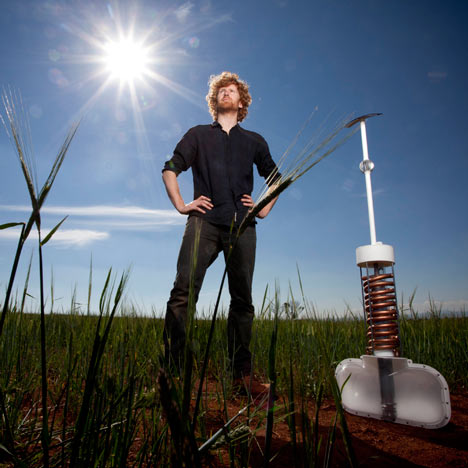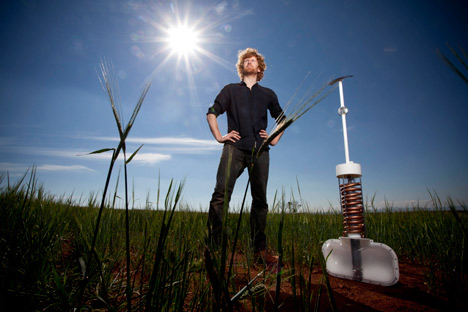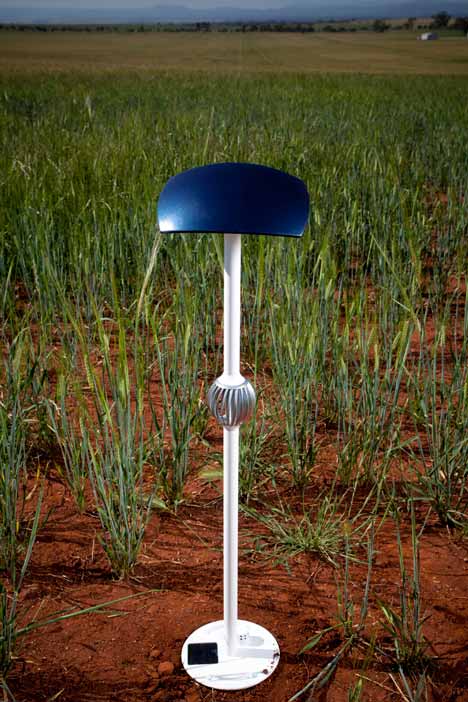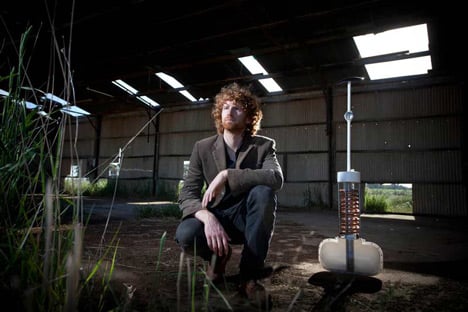
James Dyson 2011 Award winner announced
Dezeen Wire: a system that extracts moisture from air like a desert-dwelling beetle has won this year's James Dyson Award for students working on innovative engineering solutions.

Edward Linacre from Swinburne University of Technology in Melbourne chose to tackle the problem of providing water to crops in arid regions following droughts that affected Australia earlier this year.

Airdrop pumps air through underground pipes, lowering the temperature to the condensation point and the resulting water is moved around to nourish the roots of the plants.

The James Dyson Award is an international student competition organised by the James Dyson Foundation with a simple brief: "Design something that solves a problem." Linacre receives a £10,000 prize that he says he will use to develop the concept and his university department also receives £10,000.
See our previous story on the UK winner Kwick Screen by Michael Korn, which was also announced as a runner up for the overall award.
Here are some more details from the award organisers:
James Dyson Award winner 2011: Airdrop overcomes drought, with inspiration from a beetle.
Engineering, not magic: the 2011 winner of the James Dyson Award extracts water from thin air. Airdrop is a low cost, self powered, and easy to install solution to the problems of growing crops in arid regions.
Inspired by Australia’s worst drought in a century, Edward Linacre from Swinburne University of Technology in Melbourne, turned to nature to find ways of capturing moisture from air. Edward studied the Namib beetle, an ingenious species which lives in one of the driest places on earth. With half an inch of rain per year, the beetle can only survive by consuming the dew it collects on the hydrophilic skin of its back in the early mornings.
Airdrop borrows this concept, working on the principle that even the driest air contains water molecules which can be extracted by lowering the air’s temperature to the point of condensation. It pumps air through a network of underground pipes, to cool it to the point at which the water condenses. Delivering water directly to the roots of plants.
James Dyson said, “Biomimicry is a powerful weapon in an engineer’s armoury. Airdrop shows how simple, natural principles like the condensation of water, can be applied to good effect through skilled design and robust engineering. Young designers and engineers like Edward will develop the simple, effective technology of the future – they will tackle the world’s biggest problems and improve lives in the process.”
Edward’s research suggests that 11.5 millilitres of water can be harvested from every cubic meter of air in the driest of deserts. Further iterations of his design will increase the yield of Airdrop. He said, “winning the award’s £10,000 prize will mean I can develop and test the Airdrop system. It has the potential to help farmers around the world and I’m up for the challenge of rolling it out”. A further £10,000 has also be awarded to Edward’s university department to support other young engineers keen to follow in his footsteps.
Runners Up:
Kwick Screen (UK)
A portable, retractable room divider developed by Michael Korn, a student at the Royal College of Art in London. The KwickScreen allows healthcare professionals to make the best use of available space; giving maximum privacy, dignity and protection to patients. Michael explored the use bistable materials such as slap on bracelets and tape measures, and like Edward drew inspiration from concepts found in nature, including the Venus fly trap and a frog’s tongue.
Blindspot (Singapore)
An aide for the visually handicapped, helping them travel around unfamiliar surroundings, developed by Se Lui Chew from the National University of Singapore. Blindspot informs the user of nearby friends using information from geographical-based social apps such as Foursquare, and communicates with them via a Bluetooth earpiece connected to the cane. The cane guides the user to their friend using a horizontally rolling ball on the cane handle which points in the direction they should walk.
Highly Commended:
Amo Arm (Canada)
Michal Prywata from Ryerson University, Canada, developed Amo Arm to overcome the invasive muscle re-innervation surgery required for amputees. It can be strapped on and is controlled using brain signals, avoiding major surgery and the long rehabilitation period after.

Back to Dezeenwire »
Back to Dezeen »